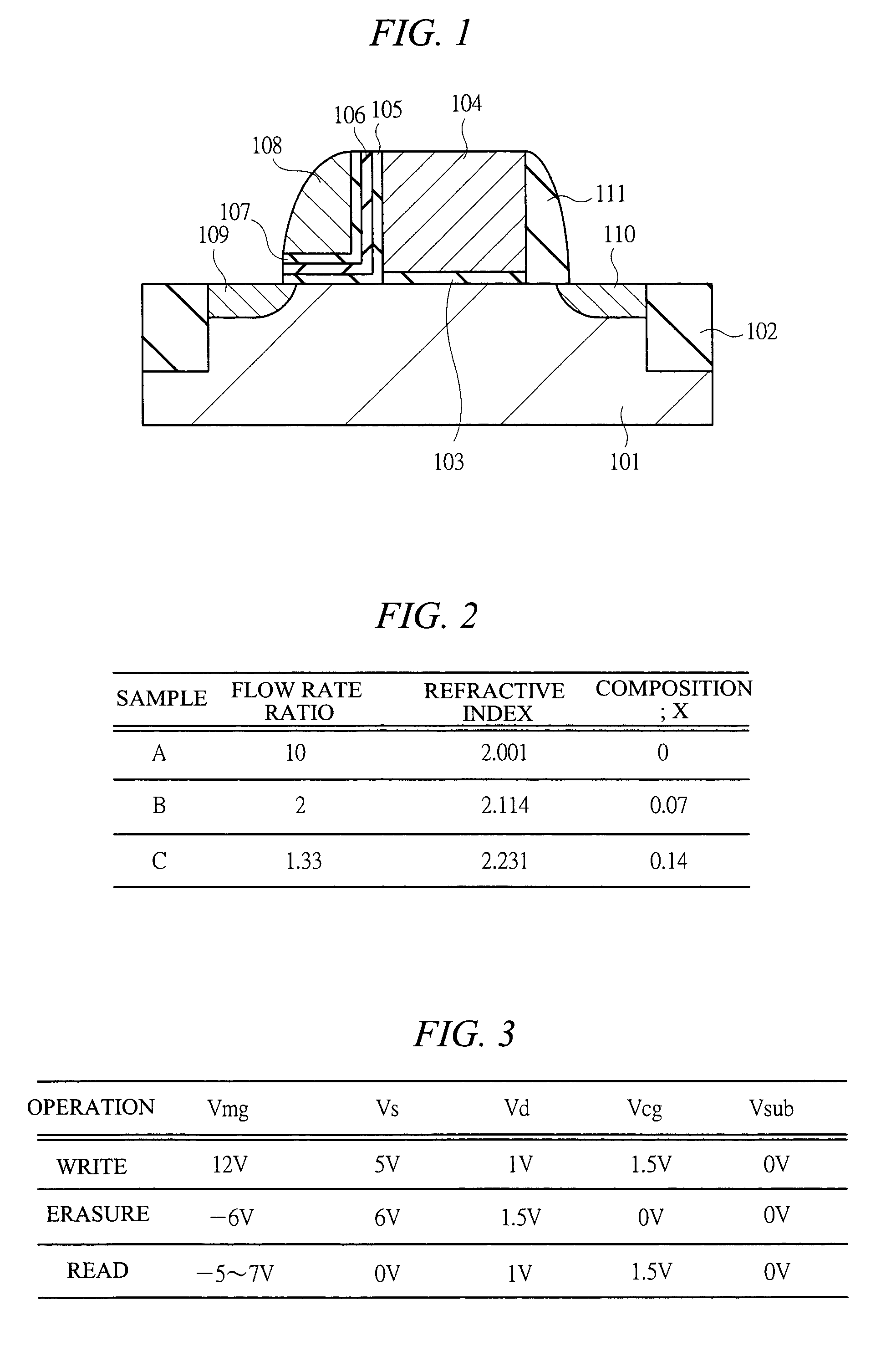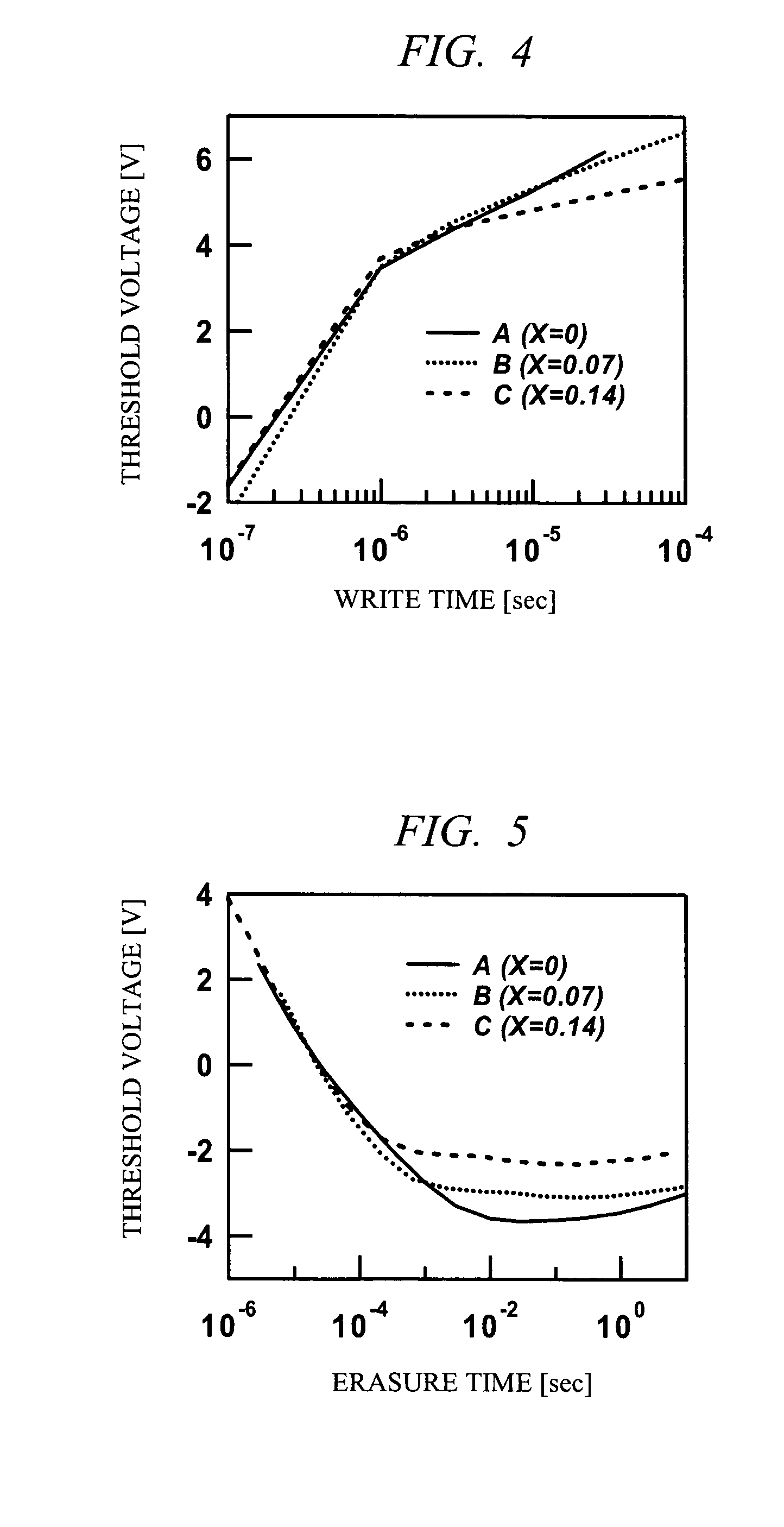Non-volatile memory device with a silicon nitride charge holding film having an excess of silicon
a non-volatile semiconductor and charge holding film technology, applied in semiconductor devices, electrical devices, transistors, etc., can solve the problems of significant reduction of data holding characteristics, difficult increase in the number of rewriting, so as to suppress the deterioration of the subthreshold coefficient, improve the performance of the non-volatile semiconductor storage device, and improve the durability of rewriting
- Summary
- Abstract
- Description
- Claims
- Application Information
AI Technical Summary
Benefits of technology
Problems solved by technology
Method used
Image
Examples
first embodiment
[0091]A first embodiment of the present invention will be described in detail by using FIG. 1 to FIG. 14. FIG. 1 is a diagram showing a cross sectional view of a non-volatile memory cell which is the first embodiment of the present invention. In practice, wiring is present in an upper layer of the drawing; however, it is omitted in this drawing. FIG. 2 shows samples fabricated in the first embodiment. The first embodiment provides examples in which, as shown in FIG. 2, as an electric charge holding film, a sample A using a film having a stoichiometrical ratio of Si3N4, a sample B using an SRN film into which silicon atoms (Si) are stoichiometrically excessively introduced, and a sample C using an SRN film into which silicon atoms (Si) are stoichiometrically excessively introduced are fabricated. The SRN film compositions of the sample B and the sample C are different, and the SRN film of the sample C further excessively contains Si. In the first embodiment, except for the electric h...
second embodiment
[0135]A second embodiment of the present invention will be described in detail by using FIG. 15 to FIG. 24. A non-volatile memory cell which is the second embodiment of the present invention has a structure which is basically same as the structure shown in FIG. 1 of the first embodiment, and merely the configuration of the electric charge holding film 106 and the composition of the SRN film are different.
[0136]FIG. 15 shows the configuration of a capacitance insulating film of the memory transistor of the second embodiment. In the second embodiment, the electric charge holding film is formed by a laminated structure of an SRN film 106a stoichiometrically excessively containing silicon and a stoichiometrically Si3N4 film 106b. The composition of the SRN film 106a is x=0.2, and the film thickness ratio of the SRN film 106a and the Si3N4 film 106b is used as a parameter. The composition of the SRN film used in the second embodiment is x=0.2 and excessively contains Si more than the fir...
third embodiment
[0150]Next, a third embodiment of the present invention will be described by using FIG. 25 to FIG. 27. A non-volatile memory cell which is the third embodiment of the present invention is a non-volatile memory cell composed of one memory transistor as shown in FIG. 25; however, basically, it has a structure approximately same as the structure of the memory transistor region of the split-gate type non-volatile memory cell shown in the first embodiment. Although wiring is present in an upper layer of FIG. 25 in practice, it is omitted also in this drawing.
[0151]The non-volatile memory cell (MONOS memory cell) is composed of one MOS transistor having a p-type well region 201, isolation regions 202, an n-type diffusion layer (n-type semiconductor region) serving as a drain region 207, an n-type diffusion layer (n-type semiconductor region) serving as a source region 208, a capacitance insulating film, and an n-type polycrystalline Si film serving as a gate electrode 206 provided on an S...
PUM
 Login to View More
Login to View More Abstract
Description
Claims
Application Information
 Login to View More
Login to View More - R&D
- Intellectual Property
- Life Sciences
- Materials
- Tech Scout
- Unparalleled Data Quality
- Higher Quality Content
- 60% Fewer Hallucinations
Browse by: Latest US Patents, China's latest patents, Technical Efficacy Thesaurus, Application Domain, Technology Topic, Popular Technical Reports.
© 2025 PatSnap. All rights reserved.Legal|Privacy policy|Modern Slavery Act Transparency Statement|Sitemap|About US| Contact US: help@patsnap.com



